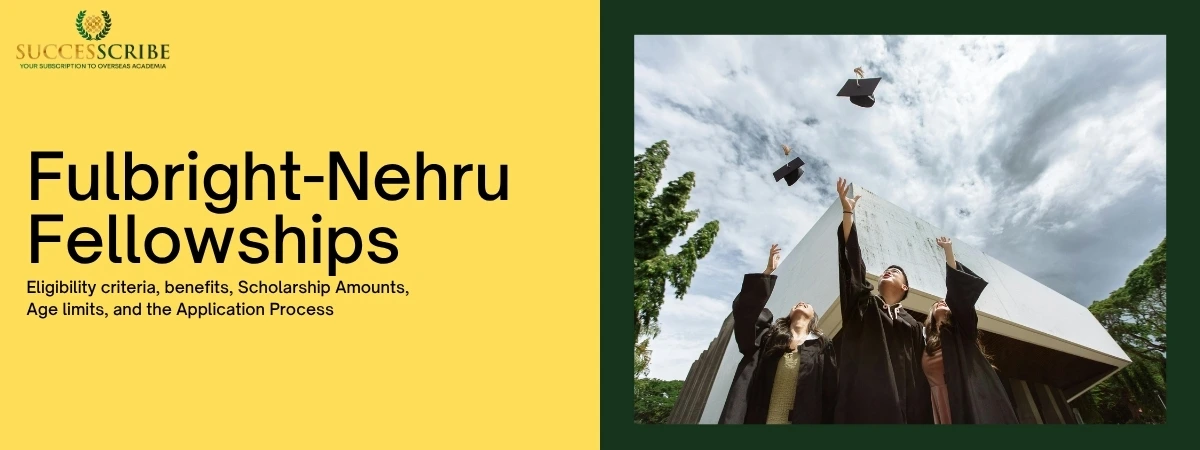The Fulbright-Nehru Fellowships represent one of the most prestigious academic and cultural exchange programs available for Indian citizens who aspire to pursue higher education, conduct research, or teach in the United States. Jointly administered by the United States-India Educational Foundation (USIEF) and the U.S. Department of State, these fellowships promote mutual understanding between India and the U.S., fostering future leaders across academic, professional, and cultural spheres.
This detailed topic explores everything you need to know about Fulbright-Nehru Fellowships, including eligibility criteria, benefits, scholarship amounts, age limits, and the application process with updated deadlines.
Introduction to Fulbright-Nehru Fellowships
Established in 1950, the Fulbright Program is one of the largest international exchange initiatives in the world. The Fulbright-Nehru Fellowships were created under this program to specifically support Indian students, researchers, and professionals who demonstrate academic excellence and leadership potential.
The fellowships are designed to:
- Facilitate educational and cultural exchange
- Promote bilateral cooperation
- Support cutting-edge research and innovation
- Foster leadership and public engagement
The Fulbright-Nehru program is fully funded, meaning it covers all essential expenses, including tuition, airfare, living stipend, and more, making it highly competitive and sought after.
Types of Fulbright-Nehru Fellowships
There are several categories under the Fulbright-Nehru umbrella, tailored to different academic and professional backgrounds:
| Fellowship Type | Target Audience | Purpose |
| Fulbright-Nehru Master’s Fellowships | Indian students | To pursue a master’s degree in the U.S. |
| Fulbright-Nehru Doctoral Research Fellowships | Ph.D. Scholars | For Indian PhD students to conduct research in U.S. institutions |
| Fulbright-Nehru Postdoctoral Research Fellowships | Recent Ph.D. graduates | For advanced research in U.S. |
| Fulbright-Nehru Academic & Professional Excellence Fellowships | Faculty & professionals | For teaching or research projects |
| Fulbright-Nehru International Education Administrators Seminar | Higher education administrators | To enhance leadership and collaboration in international education |
Suggested Post: Scholarships for undergraduates in Germany
Fulbright-Nehru Scholarship Eligibility
Eligibility is one of the most crucial aspects for applicants. Here’s a breakdown of general and specific eligibility criteria:
General Eligibility
- Must be an Indian citizen and residing in India at the time of application.
- Must have excellent academic and professional credentials.
- Must demonstrate leadership qualities and community engagement.
- Must not hold U.S. citizenship or permanent residency (Green Card).
- Must be proficient in English (IELTS/TOEFL required).
- Must agree to return to India upon completion of the program.
Category-Specific Eligibility
| Fellowship Type | Academic Requirement | Work Experience |
| Master’s | 4-year bachelor’s degree or equivalent | 3 years full-time, paid, relevant experience |
| Doctoral | Enrolled in a PhD in India | Registered for PhD at time of application |
| Postdoctoral | Ph.D. degree within the past 4 years | N/A |
| Academic & Professional | Ph.D. or terminal degree | Minimum 5 years of teaching/research experience |
| Education Admin | Mid-level admin role | At least 5 years of experience in education administration |
Meeting the minimum eligibility does not guarantee selection due to the highly competitive nature of the fellowships.
Suggested Post: Scholarships for masters in Germany
Fulbright-Nehru Scholarship for Master’s
The Fulbright-Nehru Master’s Fellowships are ideal for young professionals with leadership potential who want to pursue a one- to two-year master’s degree program at select U.S. colleges and universities.
Fields Covered:
- Arts and Culture Management
- Environmental Science and Studies
- Public Health
- Urban and Regional Planning
- Public Administration
- International Affairs
- Women’s/Gender Studies
- Journalism and Mass Communication
- Economics
- Education
1Benefits
- Full tuition support
- Round-trip airfare
- Monthly living stipend
- Accident and sickness coverage
- J-1 visa support
- Opportunity for professional networking and alumni benefits
Important Requirements
- Must have completed a bachelor’s degree (preferably 16 years of formal education)
- Must have a minimum of 3 years of full-time work experience relevant to the proposed field
- Must demonstrate strong leadership qualities and community service.
Suggested Post: Scholarships for Phd in Germany
Fulbright-Nehru Scholarship Amount and Benefits

The Fulbright-Nehru Fellowships are fully funded, offering a generous package that supports every aspect of your academic stay in the U.S.
| Category | Support Offered |
| Tuition | Full or partial tuition based on university |
| Travel | Economy-class round-trip airfare from India to the U.S. |
| Living Expenses | Monthly stipend to cover housing, food, and other daily needs |
| Settling-in Allowance | One-time allowance at the start of the program |
| Health Insurance | J-1 visa compliant accident and sickness coverage |
| Research Allowance | For doctoral/postdoctoral categories, as applicable |
| Dependent Support | In select cases for long-term fellowships, partial support may be available |
The total scholarship amount can range from $30,000 to $100,000+, depending on tuition fees and duration of the program.
Suggested Post: Scholarships for Indian students in Germany
Fulbright-Nehru Scholarship Age Limit
There is no official age limit for most Fulbright-Nehru Fellowships. However, here are some relevant insights:
| Fellowship Type | Suggested Age Range |
| Master’s | 25–35 years (ideal) |
| Doctoral | Open (typically under 40) |
| Postdoctoral | Within 4 years of PhD completion |
| Academic/Professional Excellence | Mid- to senior-level professionals |
| Education Administrators | Generally mid-career (35–50 years) |
Though there’s flexibility, applicants are expected to align with the academic/professional maturity expected by the fellowship’s objectives.
Fulbright-Nehru Fellowship Application Process
The application process for Fulbright-Nehru Fellowships is rigorous but rewarding. Here’s a step-by-step overview:
- Online Registration on USIEF Website
- Create an account and select the appropriate category.
- Complete the Application Form
- Academic records, statement of purpose (SOP), CV, letters of recommendation, and more.
- Submit Test Scores
- TOEFL is mandatory for most programs. GRE may be required for some universities.
- Letters of Reference
- Usually, 3 letters are needed. Choose referees who know your work well.
- Upload Supporting Documents
- Academic transcripts, certificates, proof of employment, research proposals, etc.
- Application Review
- Conducted by USIEF panels in India and the U.S. based on merit and fit.
- Interviews
- Shortlisted candidates are invited for personal or virtual interviews.
- Final Nomination and University Placement
- USIEF forwards nominations to U.S. universities and sponsors.
Suggested Post: how to get scholarship to study abroad
Fulbright-Nehru Scholarship Deadline
Application Timeline for 2025–2026 Cycle.
| Process Stage | Deadline |
| Application Opens | February 2025 |
| Last Date to Apply | May 15, 2025 |
| Interviews | August–September 2025 |
| Results Announcement | October 2025 |
| University Placement | November 2025–March 2026 |
| Final Selection by U.S. Authorities | April–May 2026 |
| Departure for the U.S. | July–August 2026 |
Early application is highly encouraged. Late submissions are not accepted.
History and Legacy of Fulbright-Nehru Fellowships
The Fulbright Program, initiated in 1946 by U.S. Senator J. William Fulbright, is one of the most prestigious academic exchange initiatives globally. In India, it began in 1950 and evolved into the Fulbright-Nehru Fellowships in 2008 to reflect enhanced cooperation between the U.S. and India.
| Year | Milestone |
| 1950 | Fulbright Program launched in India |
| 2008 | Rebranded as Fulbright-Nehru Fellowship to honor Nehru and reflect Indo-U.S. partnership |
| Present | Over 21,000 Indians and 9,000 Americans have participated in exchanges |
These fellowships are not only academic opportunities but instruments for diplomacy, innovation, and leadership.
Suggested Post: Technical University of Munich Scholarships
Fulbright vs Fulbright-Nehru: Key Differences

Many applicants are confused between the general Fulbright Fellowships and the Fulbright-Nehru Fellowships. Here’s a comparison to clarify:
| Feature | Fulbright (Global) | Fulbright-Nehru (India-specific) |
| Administered by | U.S. Department of State | U.S. Department of State + USIEF (India) |
| Target Audience | Global applicants | Exclusively Indian citizens |
| Types of Programs | Research, Study, Teaching, Exchange | Research, Master’s, Teaching, Education Admi |
| Application Process | Country-specific | Through USIEF only |
| Cultural Emphasis | Global | Indo-U.S. collaboration and impact in India |
Fulbright-Nehru Fellowships are tailored to India’s development priorities and aim to build human capital that contributes to both national and international communities.
Top U.S. Universities Participating in the Program

Although applicants do not apply directly to U.S. institutions, Fulbright-Nehru fellows are typically placed in top-tier universities based on their academic field, proposed study plan, and university fit. Here are some common destinations:
| University | Notable Programs for Fulbright-Nehru Fellows |
| Harvard University | Public Policy, Education, Law |
| Stanford University | Environmental Studies, Engineering, Data Science |
| Columbia University | Journalism, International Affairs, Urban Planning |
| University of Michigan | Public Health, Urban Planning, Social Work |
| MIT | Technology Policy, Innovation Management, Economics |
| Yale University | Sociology, Global Affairs, Environmental Policy |
| UC Berkeley | Development Studies, Gender Studies, Political Science |
| New York University | Media Studies, Public Administration |
Students benefit from exposure to diverse academic approaches, research networks, and cutting-edge facilities that enhance their learning and professional journey.
Suggested Post: Ludwig Maximilian University of Munich Scholarships
Common Mistakes to Avoid in the Fulbright-Nehru Application
The Fulbright-Nehru application process is comprehensive and highly competitive. Minor oversights can weaken your candidacy. Here are the most common mistakes:
- Generic SOPs: Submitting a Statement of Purpose that could apply to any scholarship program, rather than reflecting Fulbright’s unique emphasis on leadership and cross-cultural impact.
- Weak Recommendations: Selecting referees who cannot speak in detail about your capabilities, goals, and achievements.
- Ignoring TOEFL/GRE Requirements: Missing minimum required scores or submitting them late.
- Lack of India Impact Focus: Not explaining how your U.S. education or research will benefit Indian society.
- Incomplete Application: Forgetting essential documents like transcripts, work certificates, or project descriptions.
Tips Table
| Mistake | Recommendation |
| SOP too vague | Write clearly about your goals, research/study plans, and long-term societal contributions in India |
| Incomplete documents | Create a checklist and review with mentors before submission |
| Choosing wrong referees | Pick referees who are senior, articulate, and closely familiar with your work |
| Ignoring program theme | Align your goals with Fulbright’s objectives of diplomacy and development |
Breakdown of Statement of Purpose (SOP) for Fulbright
The SOP is the heart of your application. It’s your chance to explain who you are, what you aim to do, and why you are a perfect fit for the Fulbright-Nehru Fellowship.
SOP Structure
| Section | Purpose |
| Introduction | Hook + Brief academic/professional journey |
| Academic Background | How past education has shaped your goals |
| Motivation for Program | What inspired your field of interest and Fulbright application |
| Professional Experience | Showcase leadership, impact, and innovation |
| Proposed Plan in the U.S. | Intended program, research interests, target outcomes |
| Contribution to India | How you plan to apply your experience in India |
| Cultural Diplomacy | Ways in which you’ll engage with and represent India in the U.S. |
| Conclusion | Reaffirm commitment, readiness, and alignment with Fulbright values |
Sample Line:
“Equipped with a master’s in environmental policy from the U.S., I envision leading sustainable urban development initiatives in Tier-2 cities in India that balance growth with ecological preservation.”
Suggested Post: Free University of Berlin Scholarships
Re-entry and Impact in India After the Fellowship
Fulbright-Nehru Fellowships are structured around the “return and contribute” principle. Scholars are required to return to India for a minimum of two years, ensuring that the knowledge, skills, and experiences gained in the U.S. benefit Indian institutions, communities, and governance.
Common Impact Areas:
| Sector | Contributions Made by Alumni |
| Education | Setting up centers of excellence, curriculum design, teacher training |
| Public Health | Designing vaccination drives, health equity programs, rural health initiatives |
| Technology | Launching health tech and agritech startups |
| Governance | Working with NITI Aayog, State Governments, or international development bodies in India |
| Social Entrepreneurship | Founding NGOs focused on education, gender equity, or climate resilience |
Suggested Post: University of Freiburg Scholarships
Fulbright-Nehru vs Other Scholarships
When comparing global fellowships, Fulbright-Nehru stands out due to its bilateral structure, cultural mission, and long-term alumni impact.
| Feature | Fulbright-Nehru | Chevening (UK) | DAAD (Germany) |
| Country | USA | UK | Germany |
| Duration | 1–2 years | 1 year | Varies (1–3 years) |
| Funding | Fully Funded | Fully Funded | Fully Funded |
| Leadership Training | High | Very High | Moderate |
| Research Opportunities | Excellent | Limited | Strong in STEM |
| Return Requirement | Mandatory | Recommended | Optional |
Fulbright-Nehru Scholarship Myths and Facts

Despite its long-standing reputation, the Fulbright-Nehru Fellowship is surrounded by misconceptions that often discourage qualified candidates from applying. It’s crucial to distinguish myth from reality to make informed decisions during your application process.
Debunking the Most Common Myths:
| Myth | Fact |
| “Only IIT or IIM graduates get selected.” | Not true. The program values diversity of academic and professional backgrounds. Fulbright-Nehru Fellows come from a wide array of institutions, including state universities, private colleges, and niche research centers. |
| “You must already be admitted to a U.S. university.” | False. You do not need an admission offer before applying. USIEF facilitates placements at U.S. universities after the selection, aligning them with your proposed academic or research plan. |
| “A high GPA is the only thing that matters.” | Inaccurate. A strong Statement of Purpose, relevant experience, leadership potential, and your plan to contribute to India matter just as much as academic scores. |
| “There’s a strict age limit for applicants.” | Incorrect. While early- to mid-career professionals are often selected, there is no formal age limit. Applicants of all ages are encouraged to apply if they meet the eligibility criteria. |
| “Only academic researchers can apply.” | Misleading. The fellowship is open to professionals, artists, policy makers, educators, administrators, and others, not just researchers or students. |
The Fulbright-Nehru Fellowship is not reserved for elites. It’s about potential, purpose, and impact, especially how you intend to use your U.S. experience to benefit India.
Conclusion
The Fulbright-Nehru Fellowship is not just a funding opportunity it’s a powerful gateway to global impact, intellectual transformation, and lifelong leadership.
With over 21,000 Indian alumni and more than 9,000 Americans having participated in Indo-U.S. educational exchanges since 1950, the program represents one of the most successful bilateral academic collaborations in the world. These numbers reflect more than just participants, they represent changemakers, innovators, educators, and diplomats who are shaping the future of India and its place in the world.
FAQs
Do I need admission to a U.S. university before applying for the Fulbright-Nehru Fellowship?
No. You do not need to apply to U.S. universities on your own. If selected, USIEF will handle your university placement based on your academic and research interests.
Is there a minimum CGPA or percentage required to apply?
There is no fixed cut-off like 75% or 8.0 CGPA. However, academic excellence is considered as part of a holistic review, which includes your SOP, leadership potential, and intended impact in India.
What if my field of study is unconventional, like music therapy or game design?
Unconventional fields are welcome, as long as you can demonstrate the academic credibility of your field, its impact on India, and how you will pursue it in the U.S. Your passion and purpose matter most.
Do I have to return to India after the fellowship?
Yes. All Fulbright-Nehru Fellows must return to India and stay for at least two years. This is part of the agreement with the U.S. government to ensure your knowledge benefits your home country.
Will the fellowship cover family members or dependents?
Generally, the Fulbright-Nehru Fellowship does not cover dependents for master’s students. In certain categories (like research scholars), partial support or J-2 visa guidance might be available, but expenses are not covered.
Related Post
RWTH Aachen University IELTS Requirement
RWTH Aachen University top Courses
Technical University Berlin IELTS Requirement
Technical University Berlin top courses















